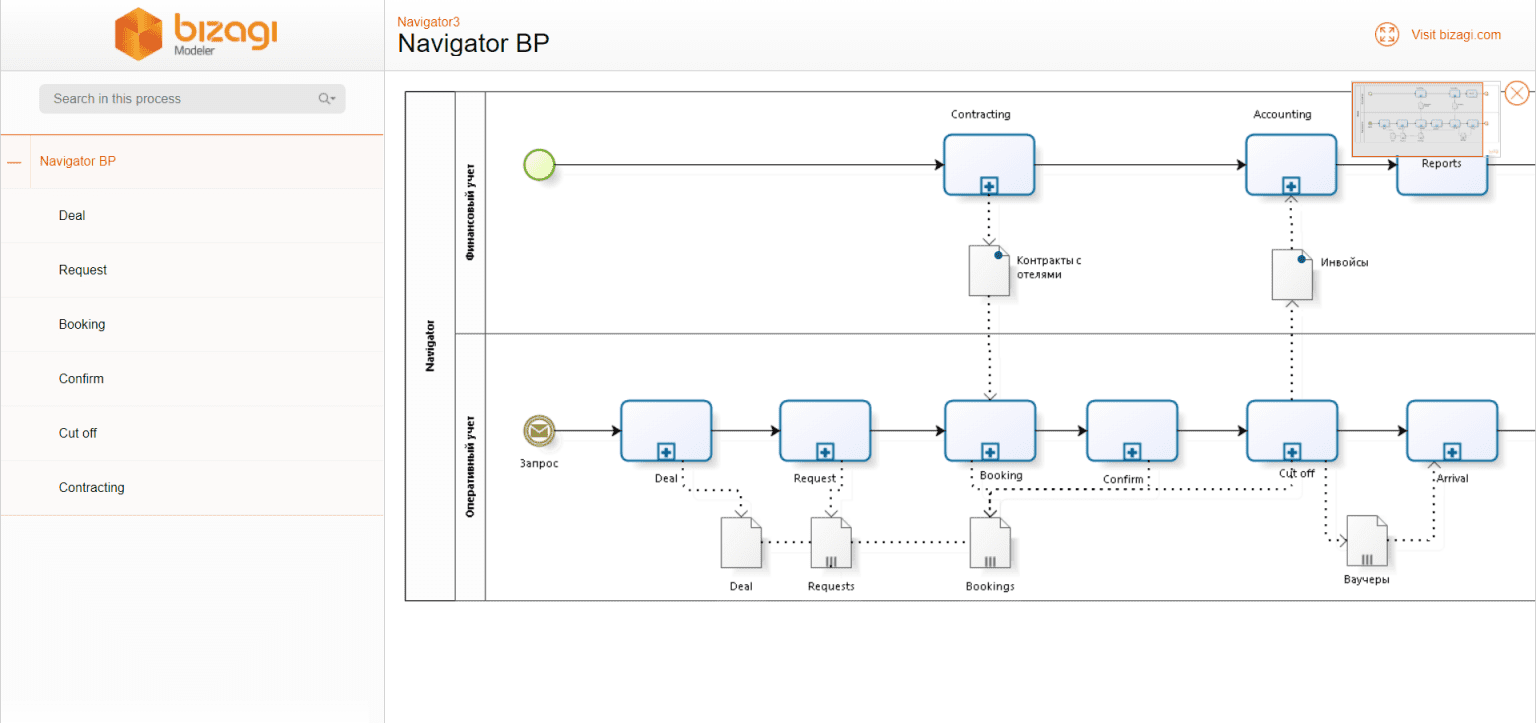What is a BPMN system and how does business process modeling work ?

Building a business process is not always a simple matter, because it is required not only to draw a certain scheme but also to think over how this or that process will practically take place, to regulate it, to bring this regulation to each employee, to test how everything happens in practice, to think over the shortcomings and options for their correction.
For modeling of the business process according to BPMN notation, the special software for modeling of business processes, capable not only to make schemes but also to provide real work of business under these schemes is used more often.
Let's understand what is BPMN system and how the modeling of BPMN business processes takes place?
BPMN - Business Process Management Notation is a system of symbols for building a business process flow diagram (business process modeling).
Any scheme of this type is based on an event. For example, events may refer to events:
- Receiving a request from a client (initial event).
- Document creation.
- Document matching.
- Sending goods to the client/providing services to the client.
- Receive feedback from the client (final event, if no feedback needs to be processed).
- Other events.
Besides events, there are gateways. They allow you to get a specific scheme of the business process because it is the gateways that regulate the movement of the process. It is numerous bundles-transitions with logical values "further", "if", "and". They allow business processes to branch off: from one event (for example, the receipt of a request) departs several gateways: fixing the request, processing the request, collecting contact information from the client, etc.
Let's consider some variants of software with which help it is possible to spend both modelling, and automation of business processes.
9 business process modeling software:
1. Bizagi Process Modeler http://www.bizagi.com/
Free software for creating process diagrams and documentation in BPMN notation. An excellent tool for building business processes. It helps not only to create, but also to publish the results of work in various formats, including MS Word and interactive HTML:

4. Camundahttps://camunda.com/products/modeler/
It is a BPM engine for business process automation.
- Open source allows you to clearly understand how the software works, and excellent documentation allows you to quickly understand how to integrate the engine into your infrastructure.
- Camunda supports the latest version of Java or any JVM language at all.
- Excellent architecture inside - the engine does what is expected of it in the most obvious and expected way. There are no unnecessary abstractions that need to be studied.
- Easy development, testing, and embedding in CI\CD due to the fact that Camunda can be used simply as a library in a Java application. Camunda does not limit a developer to any conditions. Use any convenient tools - statistical analyzers, test frames, build tools, version control tools.
Camunda is also a set of Modeler, Task List, BPMN Engine, DMN Engine, Cockpit, Admin, Optimize.
The modeler is an application for creating BPMN process models. These models are needed for other parts of the system.
The tasklist is a web application where performers perform tasks set on them by a business process.
BPMN Engine is a direct engine that is responsible for BPMN interpretation into JAVA objects, saving objects to the database, and implementing other things (activity listener type) that revolve around processes.
DMN Engine - similar to BPMN Engine, only for DMN (Decision Model and Notation)
The cockpit is a web application for viewing the state of processes. In the free version, it is heavily cropped in functionality.
Admin is a web application for managing user and user rights.
Optimize is a web-based application for business process analysis. You have to pay for it.
5. AllFusion Process Modelerhttp://www.ca.com/ru/default.aspx.
Allows for description, analysis, and modeling of data models, data meta-model builder. It occupies one of the leading positions in its market segment.
It includes three standard methodologies: IDEF0 (functional modeling), DFD (data flow modeling) and IDEF3 (workflow modeling).
6. IBM WebSphere Business Modeler http://www-03.ibm.com/software/products/us/en/modeler
IBM WebSphere Business Modeler is a software tool aimed at modeling, simulation and analysis of business processes.
The key features of IBM WebSphere Business Modeler are as follows:
- allows to form the list of indicators KPI, to bind them to elements of business process and by model simulation to predict their values. Thus, achievement of strategic and tactical goals of the company is traced.
- allows describing business processes using BPMN standard diagrams. Information about the organization can accumulate in the form of structured directories, between directories can be established relationships.
- By means of Crystal Report toolkit any kinds of reporting on model objects and regulatory reporting can be created in the system, which can be uploaded to Word, Excel, pdf and other formats.
- The system supports more than 40 types of analysis, both static (model structure is analyzed) and dynamic (model is analyzed during and after the simulation).
- possibilities of gathering and control of values of indicators allow to use the system not only as system of designing, but also as system of execution.
- models can be published in such a way that they will be available for review and analysis by the development team.
- the system easily integrates with other IBM development products.
7. ELMA http://www.elma-bpm.ru/
Russian development. There is a free version. The system of business process management is based on a simple idea: you build a model of your company's business processes using visual diagrams (BPMN notation), load these descriptions into the ELMA computer system, and the program allows you to track the execution of processes in the real practice of the enterprise.
Key features:
- in addition to the management of sequential tasks, which is beneficial to automate, there is a project management module.
- the existing system of control (including through the KPI management module) and reports creates optimal conditions for working in a team, including remotely (especially valuable for branches).
- electronic document management is connected with all modules of the system and provides storage and classification of documents. This significantly saves time and minimizes the concept of "irreplaceable employee".
- accounting of clients and access rights is solved in the CRM module: there is a function of integration with call centers. For the average user ELMA can be useful as an alternative to internal corporate mail and a task management tool.
8. Fox Manager Business Processes http://www.fox-manager.com.ua/
Free. The notation used is close to Basic Flow Chart, which is familiar to many people by its simplicity of building business processes. The program automatically builds top-level processes, displaying the interaction of categories and business processes in the form of a visual diagram. Analytical functions of the program allow you to timely notice and eliminate errors made when building the built process model, namely, to highlight processes for which no one is responsible, to find references to non-existent documents, positions, suppliers or business processes.
9. Comindware Business Application Platform https://www.comindware.com/ru/platform/
Domestic Low-code platform for modeling and management of BPMN processes and digital transformation of the enterprise.
The platform from Comindware is well suited for simplifying and deepening the automation of business processes within the framework of electronic document management systems. Approving and signing a contract is the most typical process within any company's workflow. With the help of Comindware's user tool, included in the platform functionality and accessible from any web browser, it is possible to build such a process in accordance with BPMN without unnecessary complications.






